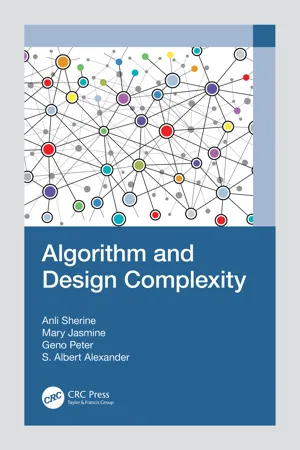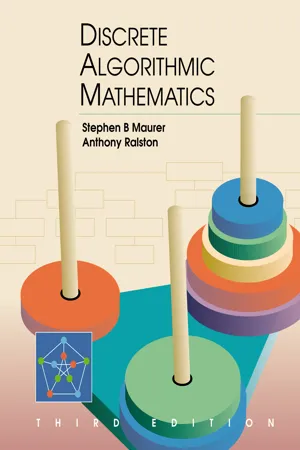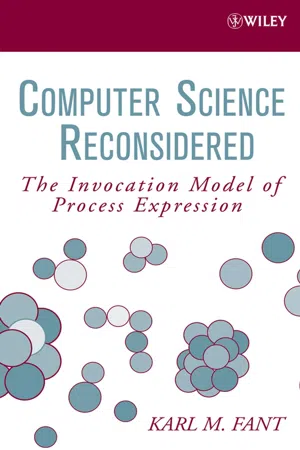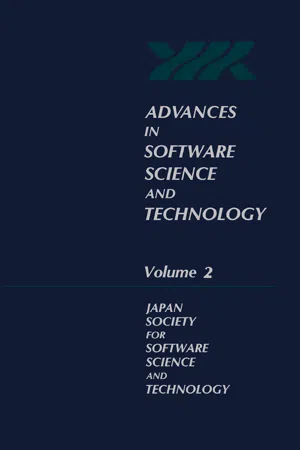Computer Science
Algorithm Analysis
Algorithm analysis involves evaluating the efficiency and performance of algorithms in terms of time and space complexity. It aims to understand how the algorithm's running time and resource usage scale with input size. This analysis helps in comparing different algorithms and selecting the most suitable one for a specific problem or application.
Written by Perlego with AI-assistance
Related key terms
1 of 5
9 Key excerpts on "Algorithm Analysis"
- eBook - PDF
- Adele Kuzmiakova(Author)
- 2020(Publication Date)
- Arcler Press(Publisher)
1.1.1. Analyzing Algorithms An algorithm is defined as a series of steps for solving a problem. The design and analysis process of algorithms is crucial for developing algorithms for solving different kinds of issues in computing and information technology. In abstract analysis of algoithms, it i’s common to approximate their complexity through the asymptotic sense, which is, estimating the complexity role for arbitrarily massive input. The word “analysis of algorithms” originally was developed by Donald Knuth. The Algorithm Analysis consists of an essential aspect of computational complexity concept, which offers theoretical valuation for the needed resources of the algorithm to resolve a particular computational problem. Many algorithms are developed to work with arbitrary length inputs. The analysis of algorithms refers to determining the aggregate of time or space resources needed to implement it. Typically, the proficiency or running period of an algorithm can be mentioned as a function pertaining to the input length of a number of steps, commonly referred to as time-complexity, memory capacity, or space complexity (KABAT, 2013). 1.1.1.1. Importance of Aalysis There i’s a need for discussing the analysis orithms and, plus how to select an advanced algorithm for solvinutational matters. Through analyarticuar problem, it i’s possible to start developing pattern recognition such that same kinds of problems may be solved with help from the algorithm. Usually, algorithms are different from each other, even though their goal is more or less the samor instance, it’sit is known that a group of numbers may be sorted by applying different algorithms. The amount of comparisons done by a single algorithm can differ from others with regards to the same input. Therefore, time complexity of the algorithms can dianwhile, there’s Computer Science, Algorithms and Complexity 4 there is need to evaluate the memory space needed by every algorithm (KABAT, 2013). - eBook - ePub
- Anli Sherine, Mary Jasmine, Geno Peter, S. Albert Alexander(Authors)
- 2023(Publication Date)
- CRC Press(Publisher)
1Algorithm AnalysisDOI: 10.1201/9781003355403-11.1 Algorithm Analysis
Why do you need to study algorithms? If you are going to be a computer professional, there are both practical and theoretical reasons to study algorithms. From a practical standpoint, you have to know a standard set of important algorithms from different areas of computing; in addition, you should be able to design new algorithms and analyze their efficiency. From a theoretical standpoint, the study of algorithms, sometimes called algorithmics, has come to be recognized as the cornerstone of computer science.Another reason for studying algorithms is their usefulness in developing analytical skills. After all, algorithms can be seen as special kinds of solutions to problems—not just answers but precisely defined procedures for getting answers. Consequently, specific algorithm design techniques can be interpreted as problem-solving strategies that can be useful regardless of whether a computer is involved. Of course, the precision inherently imposed by algorithmic thinking limits the kinds of problems that can be solved with an algorithm.There are many algorithms that can solve a given problem. They will have different characteristics that will determine how efficiently each will operate. When we analyze an algorithm, we first have to show that the algorithm does properly solve the problem because if it doesn’t, its efficiency is not important. Analyzing an algorithm determines the amount of ‘time’ that an algorithm takes to execute. This is not really a number of seconds or any other clock measurement but rather an approximation of the number of operations that an algorithm performs. The number of operations is related to the execution time, so we will sometimes use the word time - eBook - PDF
- Stephen B. Maurer, Anthony Ralston(Authors)
- 2005(Publication Date)
- A K Peters/CRC Press(Publisher)
And so on, until 100,000 people are con-tacted, each of whom can give $10. Write this up as a recursive algorithm. 1.5 The Analysis of Algorithms Designing algorithms for solving a variety of problems is one of the central themes of this book. It isn’t enough, however, merely to develop a correct algorithm. We must also reckon the cost associated with actually using the algorithm. Even though computers are becoming faster and cheaper, if an algorithm is to be used again and again on a computer, the accumulated cost may still be considerable. Therefore, we must be able to analyze the performance of an algorithm. There are two general classes of questions that may be asked about algorithms: 118 Chapter 1 Algorithms i) Analysis of Algorithms Questions . We are always interested in how well algorithms perform. Usually our mea-sure of performance will be how fast the algorithm works. This means that we are interested in the number of steps required to execute the algorithm to completion. Since the number of steps almost always depends on the amount or size of the data, we shall be trying to find the speed of an al-gorithm as a function of some quantity that represents the amount or size of the data. And, given a value of this quantity, our interest will usually be not in a particular set of the input data, but in any data that might be presented to the algorithm. We shall be interested in how fast the number of steps increases as the quantity of data increases. The ideas introduced in Section 0.3 on the rates of growth of functions will be important here. For example, we will wish to say that a particular algorithm runs in Ord( n 2 ) time, where n is our measure of the size of the data. Occasionally, instead of determining how fast an algorithm executes, we’ll be interested in how much (computer) storage it requires. The branch of mathematics and computer science concerned with the performance characteristics of algorithms is called the analysis of algo-rithms . - eBook - PDF
- Michael T. Goodrich, Roberto Tamassia(Authors)
- 2014(Publication Date)
- Wiley(Publisher)
Simply put, an algorithm is a step-by-step procedure for performing some task in a finite amount of time, and a data structure is a systematic way of organiz- ing and accessing data. These concepts are central to computing, and this book is dedicated to the discussion of paradigms and principles for the design and imple- mentation of correct and efficient data structures and algorithms. But to be able to determine the degree to which algorithms and data structures are scalable, we must have precise ways of analyzing them. The primary analysis tool we use in this book is to characterize the running time of an algorithm or data structure operation, with space usage also being of interest. Running time is a natural measure for the purposes of scalability, since time is a precious resource. It is an important consideration in economic and sci- entific applications, since everyone expects computer applications to run as fast as possible. We begin this chapter by describing the basic framework needed for analyzing algorithms, which includes the language for describing algorithms, the computa- tional model that language is intended for, and the main factors we count when considering running time. We also include a brief discussion of how recursive algorithms are analyzed. In Section 1.1.5, we present the main notation we use to characterize running times—the so-called “big-Oh” notation. These tools comprise the main theoretical tools for designing and analyzing algorithms. In Section 1.2, we take a short break from our development of the framework for Algorithm Analysis to review some important mathematical facts, including dis- cussions of summations, logarithms, proof techniques, and basic probability. Given this background and our notation for Algorithm Analysis, we present a case study on Algorithm Analysis in Section 1.3, focusing on a problem often used as a test ques- tion during job interviews. - eBook - PDF
Computer Science Reconsidered
The Invocation Model of Process Expression
- Karl M. Fant(Author)
- 2007(Publication Date)
- Wiley-Interscience(Publisher)
Computer science is primarily concerned with the nature of the expression of processes regardless of what particular process might be expressed: the nature of expression is considered independent of its process. There is much overlap between the interests of computer science and math- ematics, but the core concern with the nature of process expression itself is the unique conceptual focus that distinguishes computer science from the other sciences and from mathematics. Computer science is the science of process expression. 1.4 THE ALGORITHM IN COMPUTER SCIENCE Introductory texts on computer science often begin with a chapter on the notion of the algorithm declaring it the fundamental paradigm of computer science. Conspicuously absent from these introductory chapters is discussion of how the notion contributes to the resolution of significant problems of computer science. In the remaining chapters of these texts there is typically no further appeal to the notion of the algorithm and rarely even a usage of the word itself. The notion is never or very rarely appealed to in texts on logic design, computer architecture, operating systems, programming, software engineering, programming languages, compilers, data structures, and data base systems. The notion of the algorithm is typically defined by simply presenting a list of properties that an expression must posses to qualify as an algorithm. The following definition of an algorithm is typical: 1. An algorithm must be a step-by-step sequence of operations. 2. Each operation must be precisely defined. 3. An algorithm must terminate in a finite number of steps. 4. An algorithm must effectively yield a correct solution. 5. An algorithm must be deterministic in that, given the same input, it will always yield the same solution. This is pretty much what Hilbert proposed in 1900, and it is easy to see how this list of restrictive characteristics serves to define what is acceptable as a mathematical solution. - eBook - PDF
Fundamentals of Python
First Programs
- Kenneth Lambert(Author)
- 2018(Publication Date)
- Cengage Learning EMEA(Publisher)
When run with the same problems or data sets, processes that consume less of these two resources are of higher quality than processes that consume more, and so are the corresponding algorithms. In this chapter, we introduce tools for complexity analysis—for assessing the run-time performance or efficiency of algorithms. We also apply these tools to search algorithms and sort algorithms. Measuring the Efficiency of Algorithms Some algorithms consume an amount of time or memory that is below a threshold of toler-ance. For example, most users are happy with any algorithm that loads a file in less than one second. For such users, any algorithm that meets this requirement is as good as any other. Other algorithms take an amount of time that is totally impractical (say, thousands of years) with large data sets. We can’t use these algorithms, and instead we need to find others, if they exist, that perform better. When choosing algorithms, we often have to settle for a space/time tradeoff. An algorithm can be designed to gain faster run times at the cost of using extra space (memory), or the other way around. Some users might be willing to pay for more memory to get a faster algorithm, whereas others would rather settle for a slower algorithm that economizes on memory. Memory is now quite inexpensive for desktop and laptop computers, but not yet for some miniature devices. In any case, because efficiency is a desirable feature of algorithms, it is important to pay attention to the potential of some algorithms for poor performance. In this section, we con-sider several ways to measure the efficiency of algorithms. Measuring the Run Time of an Algorithm One way to measure the time cost of an algorithm is to use the computer’s clock to obtain an actual run time. This process, called benchmarking or profiling , starts by determin-ing the time for several different data sets of the same size and then calculates the aver-age time. - eBook - PDF
- Yoshio Ohno, Hiroyasu Kakuda, Tsutomu Kamimura(Authors)
- 2014(Publication Date)
- Academic Press(Publisher)
Just as physics has exerted an influence on mathematical concepts, so computer science is today beginning to affect them. This trend is particularly evident in the field of algorithms. In this article, we consider the history of algorithms in society and culture. 1 Formation of the Concept of Algorithm in the History of Math-ematics Loosely speaking, algorithms are procedures for reaching a goal of some kind. How-ever, the range of areas in which algorithms are used, and indeed, the contents and nature of the algorithms themselves, are extremely diverse. Copyright © 1991 by Academic Press, Inc. and 1 7 7 Iwanami Shoten, Publishers. All rights of reproduction in any form reserved. ISBN 0-12-037102-2 178 Advances in Software Science and Technology 2, 1990 Algorithms appear in a variety of contexts: as means of obtaining numerical values or function values, as techniques for judging the truth or falsehood of certain types of proposition, and as methods for winning at certain games. Where numer-ical values are computed, a method of computation — an algorithm — is always involved. It seems useful to distinguish between the discovery and simple execution of the procedure for performing calculations on the one hand, and an awareness of algorithms on the other. By awareness we mean the realization that if opera-tions or manipulations are performed according to the algorithm, the desired result will be obtained. It would seem that such an awareness appeared only long after algorithms themselves. While it is difficult to distinguish clearly between the two, if one could find examples of algorithms devised out of curiosity, not prompted by practical considerations, for studying the behavior of problems and solutions, this would constitute evidence that by that time at the latest, algorithms themselves had become objects of investigation. - eBook - PDF
Algorithms: Design Techniques And Analysis
Design Techniques and Analysis
- M H Alsuwaiyel(Author)
- 1999(Publication Date)
- World Scientific(Publisher)
For a more popular account of algorithms, see Knuth (1977), Lewis and Papadimitriou (1978) and the two Turing Award Lectures of Karp (1986) and Tarjan (1987). Some of the more practical aspects of algorithm design are discussed in Bentley (1982) and Gonnet (1984). Knuth (1973) discusses in detail the sorting algorithms covered in this chapter. He gives stepcounting analyses. The asymptotic notation was used in mathematics before the emergence of the field of algorithms. Knuth (1976) gives an account of its history. This article discusses the R and 8 notations and their proper usage and is an attempt to standardize these notations. Purdom and Brown (1985) presents a comprehensive treatment of advanced techniques for analyzing algorithms with numerous examples. The main mathematical aspects of the analysis of algorithms can be found in Greene and Knuth (1981). Weide (1977) provides a survey of both elementary and advanced analysis techniques. Hofri (1987) discusses the average-case analysis of algorithms in detail. Chapter 2 Mathematical Preliminaries When analyzing an ~ o r i t h m , the amount of resources required is usually expressed as a function of the input size. A nontrivial algorithm typi- cally consists of repeating a set of instructions either iteratively, e.g. by executing a for or while loop, or recursively by invoking the same algo- rithm again and again, each time reducing the input size until it becomes small enough, in which case the algorithm solves the input instance using a straightforward method. This implies that the amount of resources used by an algorithm can be expressed in the form of summation or recursive formula. This mandates the need for the basic mathematical tools that are necessary to deal with these summations and recursive formulas in the process of analyzing an aigorithm. - No longer available |Learn more
- (Author)
- 2014(Publication Date)
- White Word Publications(Publisher)
____________________ WORLD TECHNOLOGIES ____________________ Chapter 10 Algorithmic Efficiency In computer science, efficiency is used to describe properties of an algorithm relating to how much of various types of resources it consumes. Algorithmic efficiency can be thought of as analogous to engineering productivity for a repeating or continuous process, where the goal is to reduce resource consumption, including time to completion, to some acceptable, optimal level. Software metrics The two most frequently encountered and measurable metrics of an algorithm are:- • speed or running time - the time it takes for an algorithm to complete, and • 'space' - the memory or 'non-volatile storage' used by the algorithm during its operation . but also might apply to • transmission size - such as required bandwidth during normal operation or • size of external memory- such as temporary disk space used to accomplish its task and perhaps even • the size of required 'longterm' disk space required after its operation to record its output or maintain its required function during its required useful lifetime (examples: a data table , archive or a computer log) and also • the performance per watt and the total energy, consumed by the chosen hardware implementation (with its System requirements, necessary auxiliary support systems including interfaces, cabling, switching, cooling and security), during its required useful lifetime. (An extreme example of these metrics might be to consider their values in relation to a repeated simple algorithm for calculating and storing ( π +n) to 50 decimal places running
Index pages curate the most relevant extracts from our library of academic textbooks. They’ve been created using an in-house natural language model (NLM), each adding context and meaning to key research topics.








